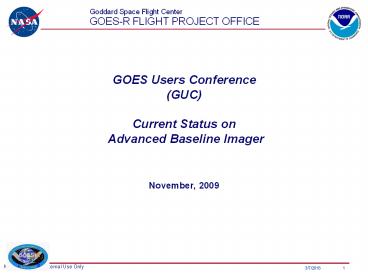GOES Users Conference (GUC) Current Status on Advanced Baseline Imager - PowerPoint PPT Presentation
1 / 11
Title:
GOES Users Conference (GUC) Current Status on Advanced Baseline Imager
Description:
Sensor Unit modal testing correlated SU FEM first modes ... Data collections presenting real data to analysis teams and software ... – PowerPoint PPT presentation
Number of Views:21
Avg rating:3.0/5.0
Title: GOES Users Conference (GUC) Current Status on Advanced Baseline Imager
1
GOES Users Conference(GUC)Current Status on
Advanced Baseline Imager
- November, 2009
2
Terminology
- Prototype Model (PTM)
- Not a flight instrument
- Pathfinder to demonstrate ABI design and test
program - Qualification model for ABI design and test
program - Built, integrated, and in the midst of
instrument-level testing - Protoflight Model (PFM)
- First flight instrument
- Will be tested at protoflight levels
- Many components and some assemblies are in
production - Ground Processing Development System (GPDS)
- Implementation of all ABI ground processing
algorithms on real hardware run in real time
proving latency requirements are met - Same software used to process PTM data
3
Executive Summary ABI Meeting Mission
Requirements
- ABI is a significant advancement over current
Imager - System design proven robust
- System architecture has not changed since PDR
- Completed PTM subsystem testing
- Bench test ongoing
- PTM (pathfinder) is doing its job
- Risks mitigated early to ensure successful flight
program
4
ABI System Consists of 3 Units Plus Ground
Algorithms
Algorithms Decompression, Calibration,
Navigation, Resampling
5
ABI vs. GOES-N Imager 48x Increase in
Information Plus Operational Flexibility
- Temporal 6x
- Full Earth disk 5 minute vs. 30 minutes
- 15 minutes 1 full Earth disk 3 CONUS 30
mesoscales - Spectral 3x
- 16 channels (0.47-13.3 µm) vs. 5 channels (0.64 -
13.3 µm) - Spatial 2x
- 0.64 µm channel 14 µrad (0.5 km) vs. 28 µrad (1
km) - 0.47, 0.86, and 1.61 µm channels 28 µrad (1 km)
- Other channels 56 µrad (2 km) vs. 116 µrad (4
km) - 24/7 Operations
- Operation through eclipse and within 3 of sun
- Data rate 26x
- lt 66.6 Mbps compressed vs. 2.6 Mbps uncompressed
5
6
Strengths of ITTs ABI
- Scans parallel to equator with no image plane
rotation - Greatly simplifies ground processing
- Doesnt require a yaw flip
- But can operate in yaw flipped configuration by
setting a single bit ground commanding need not
change - Scan patterns and rates fully configurable on
orbit - New scenes and timelines can be uploaded post
launch - Optimized system delivers no gaps with little
overlap (1) - INR performance delivered for all images, not
just full disk - Rapid slews generate little spacecraft
disturbance - Optimized slew profiles
6
7
PTM Instrument Bench Test Underway
- Integration successfully completed on 5/28
- Bench test phases 2 of 3 completed
- Performance data collected for all electrical and
most optical tests - Images collected and processed
- Operational scan scenarios successfully executed
- System architecture remains stable
- GSE and test developments on-track to support
system test - PTM completion in 2010
Completed ABI PTM Sensor Unit
8
No Showstoppers in System Development
KEY
Waiting test/analysis
Qualified for PTM/PFM
Demonstrated
Assy/part issue
Significant Issue
Cardinal System Functions System Attributes
Produce Calibrated Radiance IR Calibration Target
Produce Calibrated Radiance Solar Calibrator
Collect Radiance Field of Regard
Collect Radiance Mode 3 timeline
Collect Radiance Mode 4 timeline
Collect Radiance Alignment
Collect Radiance Pointing
Condition Radiance 16 channels (filters)
Convert Radiance to Digital Counts Video Processor
Convert Radiance to Digital Counts Focal Plane Assembly (FPA)
Process Data CCSDS packetization
Process Data Bit trimming
Process Data Compression
Interface w/Spacecraft High Speed I/O (HSIO)
Interface w/Spacecraft Instrument Controller (IC)
Manage Environment (vibe, thermal, EMI) SU, CCE, and EU structure
Manage Environment (vibe, thermal, EMI) Thermal Control
Manage Environment (vibe, thermal, EMI) Cables
8
9
PTM Demonstrating ABI Design
- System design remains stable
- No architectural changes since PDR
- PTM executing scan mode 3 4 timelines
- Scanner works
- Producing images
- Sensor Unit modal testing correlated SU FEM first
modes - 1st mode at 57.6 Hz 2nd mode at 63.6 Hz
- Coherent noise data no significant frequency
content - Polarization performance meeting expectations
PTM Is Effectively and Efficiently Paving the
Path to Flight
10
Ground Processing Algorithms Performance
Demonstrated Using Simulated Data
Channel 9.61 um 2.0 km (LWIR)
- Input generated by AIPS
- Earth, space look, and blackbody all simulated
- Unique gain offset for every detector element
- All sources of noise added
- Bit-trimmed compressed
- GPDS processing
- Decompression
- Calibration
- Using space look blackbody scenes
- Navigation
- Resampling
No striping in final image!
Same algorithms used toprocess PTM data
10
11
Summary - PTM Collecting Real Images
- Scan Modes 3 and 4 work
- Custom timelines work
- Mechanisms for collecting data work well
- Mechanisms for adjusting instrument performance
are working - Data collections presenting real data to analysis
teams and software
PTM Demonstrating ABI Will Deliver Significantly
ImprovedImager Data for Weather Forecasting
Other Products
11































